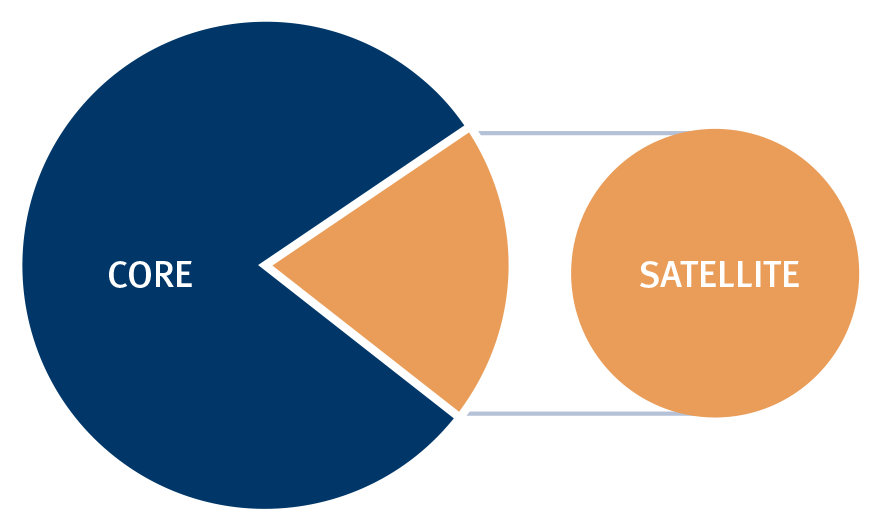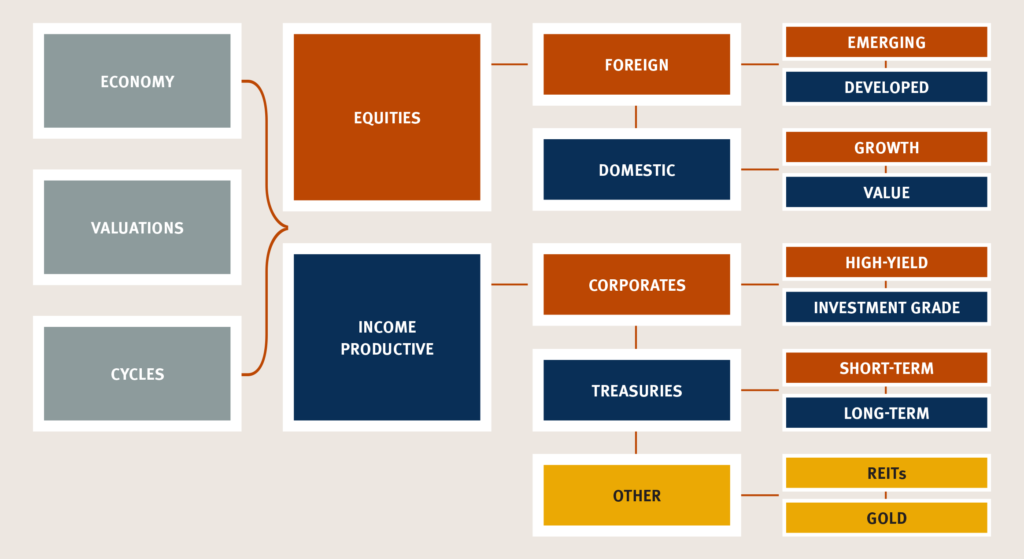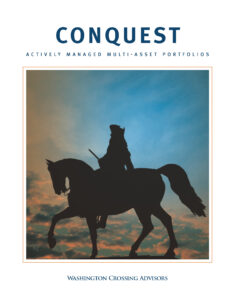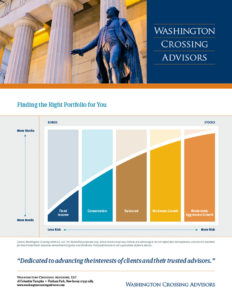CONQUEST
Risk-Focused Active Asset Allocation
CONQUEST is a suite of professionally managed asset allocation portfolios that seek to control risk and generate solid risk-adjusted returns above the rate of inflation. Continuously managed by the Washington Crossing Advisors team for over a decade, CONQUEST active asset allocation portfolios offer a seasoned, top-down, active alternative to traditional “buy-and-hold” asset allocation strategies.
Risk Management
Portfolios are available with different target asset mixes around which equity exposure can vary (±15%) based on Washington Crossing’s shorter-term market views. Further, portfolios allow for some deviation from long-run target allocations based on evolving market conditions. We seek to manage risk by combining long-run strategic and shorter-term active perspectives in one portfolio.
Two Ways
- Strategic Asset Allocation Choice
Sometimes called the “strategic” or “policy” allocation, this involves the overall, long-term mix of assets. You and your advisor can work together to find what overall strategic allocation best suits your needs.
Note: The special report, “Investing in Times of Uncertainty” may be helpful in talking to your advisor about the strategic asset allocation choice. - Ongoing Active Management
Because market prices and risk constantly change, active management can play a role in addressing risk and potentially exploiting opportunities.
Portfolio Construction
We view each portfolio as having two parts (chart, below). The “satellite” takes a short-term perspective and focuses on month-by-month fundamental market and economic trends. The “core” of the portfolio evaluates prospects over a one-to-three year forecast horizon. A major advantage of combining short and longer perspectives in one portfolio is the potential to outperform a benchmark while carefully managing risk exposures to a long-run plan.
Core-Satellite

70% Core (1-3 Year Ahead Focus)
A diversified mix of assets focused on long-run expected risk and reward. Evolving risk and return expectations, based on valuation and relative price momentum, determines the weightings of assets relative to the benchmark’s risk exposures.
30% Satellite (3-6 Month Ahead Focus)
A regular evaluation of month-to-month fundamental trends determines the mix of stocks and bonds in the “satellite.” When the 3-6 month forecast of incoming data is expected to show improvement, the satellite will be more heavily concentrated in stocks over bonds. A deteriorating forecast shifts the mix toward bonds and away from stocks.
Target Asset Mixes
Portfolios are diversified among various asset classes through exchange-traded funds (ETFs). Each portfolio has a defined target mix of stocks, bonds, and alternative assets. Deviations from the target stock/bond mix can range from 0 to 15% based on Washington Crossing Advisors’ evolving active decisions.
Overview
Active Range: ±15% vs. Target
| Portfolio | Stocks | Bonds | Alts** |
|---|---|---|---|
| Aggressive Growth | 100% | — | — |
| Moderate Growth * | 63% | 27% | 10% |
| Balanced * | 45% | 45% | 10% |
| Conservative * | 27% | 63% | 10% |
| Fixed Income | — | 100% | — |
* Tax free municipal fixed income option available
** Includes high yield corporate bond, gold, real-estate asset classes
Aggressive Growth
100% Common Stocks
Primarily invests in equity funds. Capital appreciation is the dominant driver of return, with income as a secondary consideration. This portfolio may be appropriate for investors with very long-term investment goals (15+ years) and a high risk tolerance.
Moderate Growth
63% Common Stocks | 27% Bonds | 10% Alts
Primarily invests in equity funds with a smaller allocation to fixed income. Capital appreciation is emphasized over current income. This portfolio may be appropriate for investors with long-term investment goals (10+ years) and higher risk tolerance.
Balanced
45% Common Stocks | 45% Bonds | 10% Alts
A mix of equity and fixed income investments. This portfolio may be appropriate for investors with a medium investment time horizon (7+ years) and a moderate risk tolerance.
Conservative
27% Common Stocks | 63% Bonds | 10% Alts
Mainly focused on the fixed income asset class, but also includes some exposure to equities. This portfolio may be appropriate for investors with goals that need to be met over a shorter investment time horizon (5+ years) and a lower risk tolerance.
Fixed Income
100% Bonds | 0% Bonds | 0% Alts
This portfolio invests entirely in the fixed income asset class. The portfolio may be appropriate for investors with goals that fall within a short investment time horizon (3+ years) and low risk tolerance. This portfolio might also be considered as an active fixed income “sleeve” alongside a stand-alone equity strategy.
Ongoing Management
Many asset allocation strategies only consider the long-run, often viewed as a decade or more. By contrast, CONQUEST active asset allocation (TAA) recognizes that shorter-term considerations are also important. CONQUEST involves making short-to-intermediate term adjustments to asset class weights based on shorter-term predictions of relative performance among asset classes.
To add value over the short-term, we seek to exploit temporary deviations of asset-class values from their expected long-term relationships. Changes in the underlying risk and pricing of asset classes, and observations about the economy, credit cycle, and market fundamentals, can cause our short-term return expectations to differ from longer-term views. The decision tree below highlights important portfolio decisions that may require ongoing monitoring and management.
Decision Tree

Summary
CONQUEST is a seasoned program of active asset allocation using exchange-traded funds. A variety of target asset mixes, including stocks, bonds, and other assets, are available to fit different risk requirements and long-run expectations. Because short-term views can differ from longer-term expectations, CONQUEST seeks to add value by exploiting these differences through measured active adjustments on an ongoing and systematic basis.
We believe CONQUEST is appropriate for an investor who seeks a diversified portfolio for the long-run, and wishes to preserve some flexibility and seek higher returns through ongoing, professional active management.





